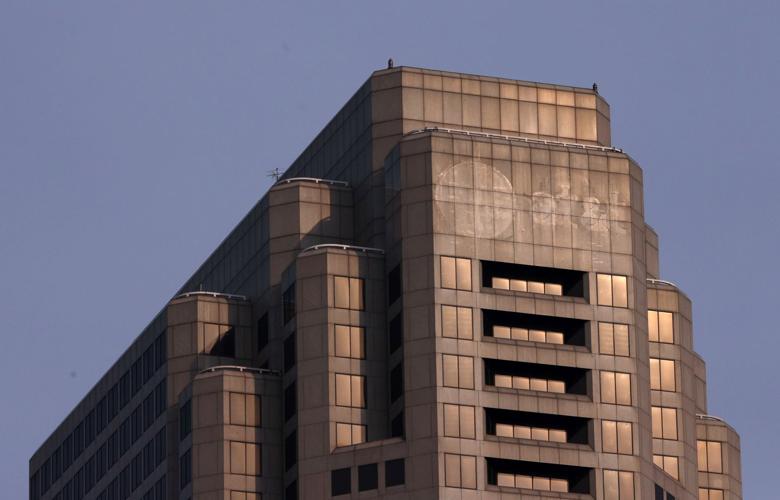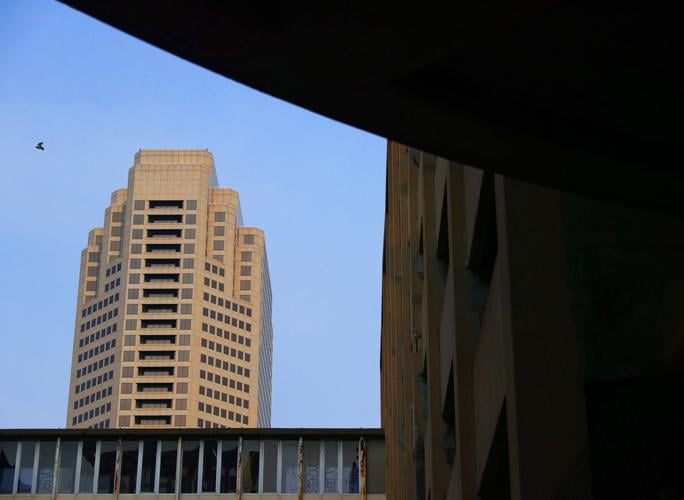ST. LOUIS — A deal to sell the vacant AT&T tower is dead, leaving real estate brokers and developers saying that it may be years before the building is redeveloped.
The sale was expected to close this summer, but real estate sources confirmed the 1.4 million-square-foot building — St. Louis’ largest office tower — is no longer under contract. It’s not clear what led to the fallout — bondholders who own the property never publicly disclosed the potential buyer. But the prospect was alluring enough that bondholders canceled an online auction for the property in March.
The deal had offered hope for both the revitalization of the 44-story building and downtown, which has one of the highest vacancy rates in the region. At least three other significant buildings have sat vacant downtown for years:
• The Jefferson Arms, at Tucker Boulevard and Locust Street, has been empty since 2006.
People are also reading…
• The Millennium Hotel, on Fourth Street just south of the Gateway Arch, closed in 2014.
• The Railway Exchange building, once home to May Department Stores at Seventh and Olive streets, has been vacant since technology incubator T-REX moved out of the 1.2-million-square-foot building in 2014.
“It’s unfortunate that the AT&T building hasn’t sold,” Dustin Allison, senior vice president and chief real estate investment officer for the region’s business group, Greater St. Louis Inc., said in an email. “This is one of a few larger properties sitting vacant, and repositioning them is a longer-term issue we, as a region, must address.”
The tower, at 909 Chestnut Street, sits a few blocks north of Busch Stadium and takes up an entire city block. It was built in 1986 for AT&T, then known as Southwestern Bell. A few years later, the company moved its corporate headquarters to San Antonio, Texas, but kept a sizable presence here. AT&T sold the building in 2006 for $205 million to MB REIT, a subsidiary of Minto Holdings of Florida and Chicago-based Inland American Real Estate Trust. The deal was financed by investment bank Bear Stearns, which failed two years later amid banking turmoil during the Great Recession.
When AT&T’s lease ended in September 2017, about 2,000 employees relocated to buildings at 801 Chestnut and 1010 Pine streets.
That same year, U.S. Bank sued the owner and foreclosed on the building. The building has been in receivership ever since. Bondholders today hold some $113 million in debt on the building. The property was last appraised this past January for $14 million.
Few developers have shown an appetite to redevelop the property.
The March auction was at least the sixth attempt by bondholders to sell the property since 2017. Bidding started at $2.85 million, significantly lower than the starting price of $7 million at auctions in 2019 and 2020. Bondholders also declined a 2018 offer for about $20 million from Bob Clark, executive chairman and CEO of the construction company Clayco, and his development partner Larry Chapman. But in subsequent offers, other undisclosed buyers walked away from potential deals, according to financial filings made to bondholders. It’s not clear why the deals failed.
The building’s size makes it a challenging redevelopment. Downtown’s weak office market, made worse by the pandemic, means any reimagining of the building will need to incorporate other uses such as residential, hotel or retail.
Office vacancy is up across the metro area, averaging 16.9% in the second quarter of 2021 compared with 11.8% in 2020. Rents for offices outside of downtown declined nearly 4% from the end of 2020 through the second quarter of 2021, according to commercial real estate firm Cushman & Wakefield.
Vacancy downtown has risen more than 1 percentage point in the past year, to 20.8% from 19.3% in the second quarter of 2020. And rents have fallen by more than 1% to $19.48 per square foot.
“We’ve got two of the largest buildings in the state of Missouri sitting empty in downtown St. Louis, with the Railway Exchange and AT&T buildings,” said Alderman Jack Coatar, whose ward includes those buildings.
“They’re big projects, and they’re going to require the city to be both a partner and contribute financially,” he said.
Coatar said developers have told him they’re holding back on new projects until they learn what Mayor Tishaura O. Jones’ development priorities are. Jones, who took office in April, vetoed bills granting tax incentives to two projects before working out a deal with at least one of those developers to build workforce housing in North City. Coatar said the vetoes sent a “bad sign” to the development community.
Nick Dunne, spokesman for Jones, said the mayor’s priorities are clear.
“We want to see whole city thrive,” Dunne said. “We want to make sure public incentives are producing public goods.”
But there are other challenges downtown should tackle first, Coatar said — namely, keeping downtown workers safe in regards to violent crime and COVID-19, and then, beefing up occupancy at existing office buildings.
“Realistically, these are privately held buildings that from street level are still in decent shape,” Coatar said. “There’s little the city can do to wrest these from private owners unless they don’t pay taxes.”












